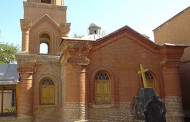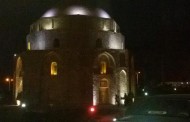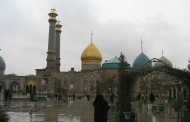Qazvin , also Romanized as Qazvīn, Caspin, Qazwin, or Ghazvin) is the largest city and capital of the Province of Qazvin in Iran. Qazvin was an ancient capital in the Persian Empire and nowadays is known as the calligraphy capital of Iran. It is famous for its Baghlava, carpet patterns, poets, political newspaper and pahlavi (Middle Persian) influence on its accent. At the 2011 census, its population was 381,598.
Located in 150 km (93 mi) northwest of Tehran, in the Qazvin Province, it is at an altitude of about 1,800 m (5,900 ft) above sea level. The climate is cold but dry, due to its position south of the rugged Alborz range called KTS Atabakiya.
History
The city was a former capital of the Persian Empire under Safavids. It is a provincial capital today that has been an important cultural center throughout history.
Archeological findings in the Qazvin plain reveal urban agricultural settlements for at least nine millennia. Qazvin geographically connects Tehran, Isfahan, and the Persian Gulf to the Caspian seacoast and Asia Minor, hence its strategic location throughout the ages.
The city today known as Qazvin is thought to have been founded by Shapur II, King of Persia in 250 CE, under the name Shad Shahpur (shad can be read as ‘happy’), when he built a fortification there to control regional tensions.
Qazvin has sometimes been of central importance at major moments of Iranian history. It was captured by invading Arabs (644 AD) and destroyed by Hulagu Khan (13th century). After the Ottoman capture of Tabriz, Shah Tahmasp (1524–1576) made Qazvin the capital of the Safavid empire (founded in 1501 AD), a status that Qazvin retained for half a century until Shah Abbas I moved the capital to Isfahan
In 1210 the city was conquered and sacked by the forces of Kingdom of Georgia sent by Tamar the Great, as per the retribution for destroying Georgian-controlled Ani by the Muslim forces that left 12,000 Christians dead.
In the 19th century Qazin flourished as a center of trade because the only all-year accessible road from the Caspian Sea to the Highland started here and with enhanced traffic on the Caspian Sea the trade volume grew. Its bazaars were enlarged. In the middle of the century the Babi movement had one of its centers here and the first massacre of Babis occurred in Qazvin in 1847.
In the second half of the 19th century Qazvin was one of the centers of Russian presence in northern Iran. A detachment of the Persian Cossack Brigade under Russian officers was stationed here. From 1893 this was the headquarters of the Russian Company for Road construction in Persia which connected Qazvin by roads to Tehran and Hamadan. The company built a hospital and the St. Nicolas Church.
In 1920 Qazvin was used as a base for the British Norperforce. The 1921 Persian coup d’état that led to the rise of the Pahlavi dynasty was launched from Qazvin.
It became a state in 1996.
In Autumn 2015 portions of Qazvin were struck by a meteorite.
Attractions
Qazvin contains several archeological excavations. In the middle of the city lie the ruins of Meimoon Ghal’eh, one of several Sassanid edifices in the area.
Qazvin contains several buildings from the Safavid era, dating to the period in which it was capital of Persia. Perhaps the most famous of the surviving edifices is the Chehelsotoon (Kolah Farangi) mansion, today a museum in central Qazvin.
After Islam, the popularity of mystics (tasawwuf), as well as the prominence of tradition (Hadith), religious jurisprudence (fiqh), and philosophy in Qazvin, led to the emergence of many mosques and religious schools. They include:
- Jame’ Atiq Mosque of Qazvin
- Heydarieh mosque
- Masjed Al-nabi (Soltani Mosque): With an area of 14000 m2, this mosque is one of the most glorious mosques of antiquity, built in the Safavieh’s monarchy era.
- Sanjideh Mosque: Another mosque of Qazvin dating back to pre-Islamic Iran; a former fire temple. Its present-day form is attributed to the Seljukian era.
- Panjeh Ali Mosque: A former place of worship for royal harem members in the Safavid period.
- Peighambarieh School-Mosque: Founded 1644 according to inscription.
- Peighambarieh Shrine: Where four Jewish saints who foretold the coming of Christ, are buried.
- Molla Verdikhani School-Mosque: Founded in 1648.
- Salehieh Madrasa and Mosque: Founded in 1817 by Mulla Muhammad Salih Baraghani.
- Sheikhol Islam School-Mosque: Renovated in 1903.
- Eltefatieh School: Dating back to the Il-Khanid period.
- Sardar School- Mosque: Made by two brothers Hossein Khan and Hassan Khan Sardar in 1815, as a fulfillment of their promise if they came back victorious from a battle against the Russians.
- Shazdeh Hosein Shrine
- Aminiha Hosseiniyeh
- Russian Church
- Caravanserai of Sa’d al-Saltaneh
About 100 km (62 mi) south-west of Qazvin are the tombs of two Saljuki era princes — Abu Saeed Bijar, son of Sa’d, and Abu Mansur Iltai, son of Takin — located in two separate towers known as the Kharraqan twin towers. Constructed in 1067 CE, these were the first monuments in Islamic architecture to include a non-conic two-layered dome. Both towers were severely damaged by a devastating earthquake in March 2003.
Qazvin has three buildings built by Russians in the late 19th/early 20th century. Among these is the current Mayor’s office (former Ballet Hall) and a water reservoir. St. Nicholas church was built in 1904 by the Russian Company for Roads in Persia which had its headquarter here. The church was in use until being decommissioned in 1984 because the community of Russian emigres in Qazvin did not exist any more. The iconostasis and bell was removed to Tehran and the building handed over to the Iranian government which keeps it available to the public as a historic monument. In front of the church is a 1906 memorial to a Russian road engineer.

The Russian Church of Qazvin today sits adjacent to the campus of Islamic Azad University of Qazvin.
Bridges
- Naderi
- Molasadra
- Ertebatat
- Persian Gulf (Khalij Fars)
- Abotorabi
- Nasr
- Motahari
- Imam Ali
- Rajaei
TOP SIGHTS IN QAZVIN
Caravanserai of Sa’d al-Saltaneh
The Caravanserai of Sa’d al-Saltaneh is a large Caravanserai located in the city of Qazvin in Qazvin Province of Iran. Built during the Qajar e... Read more
Russian Church, Qazvin
The Russian Church (Persian: Kelisā ye Rusi), also known as the Cantor Church , is a Russian Orthodox church in Qazvin, Iran. History and design The... Read more
Chehel sotoun, Qazvin
Chehel Sotoun, a Safavid pavilion located in Qazvin which stands amid gardens in the central square of the old city and in which the Qazvīn museum is... Read more
Heidarieh Mosque, Qazvin
Heydarieh mosque of Qazvin is a building in the city of Qazvin in Iran. Although renovated by Amir Khomär-täsh (Malikshah’s vizier) after the ea... Read more
Meimoon Ghal’eh
Meimoon Ghal’eh Castle, also known as Mehman Ghal’eh Castle, is one of several castle ruins scattered throughout the Qazvin area, in Iran.... Read more
Al-Nabi Mosque, Qazvin
The al-Nabi Mosque (also known as: Masjed-e Soltani) is a famous mosque in Qazvīn. The mosque has an area of about 14,000 m², and bears inscriptions i... Read more
Jameh Mosque of Qazvin
Jame Mosque of Qazvin ( Masjid-e-Jameh Atiq Qazvin) is one of the oldest mosques in Iran, and is the grand, congregational mosque (Jameh Mosque) of Qa... Read more
Aminiha Hosseiniyeh
Aminiha Hosseiniyeh is a historic hosseiniyeh in the Akhund (Molavi) neighbourhood of Qazvin, Iran. Built in 1858, it comprises 16 interconnected stru... Read more
Kharraqan towers
The Kharraqan towers are mausoleums, built in 1067 and 1093, located on the plains in northern Iran, near Qazvin. The brick structures stand 15 metres... Read more



















